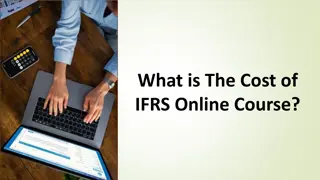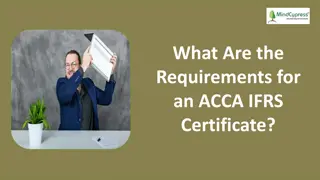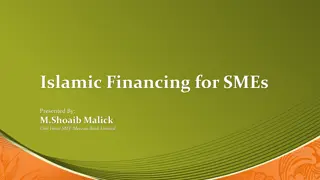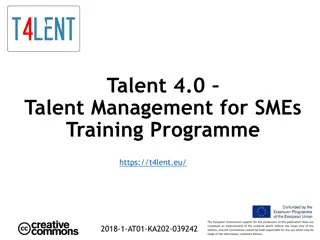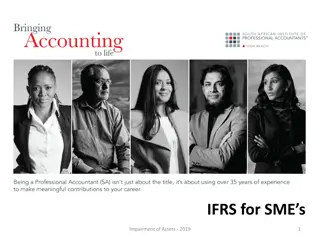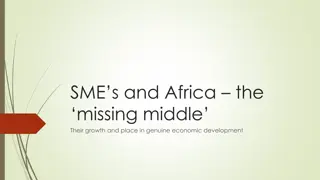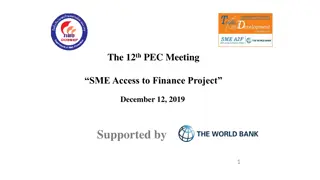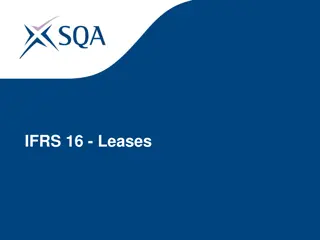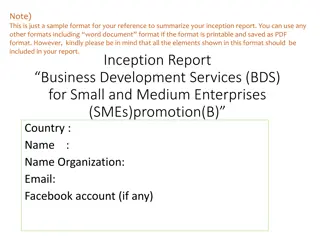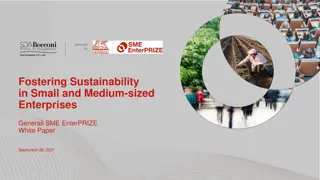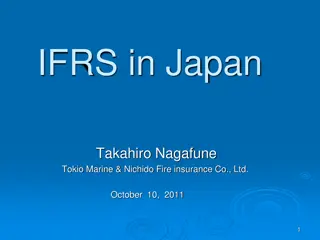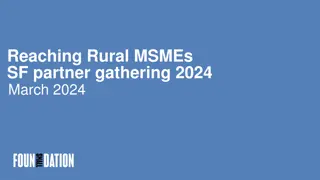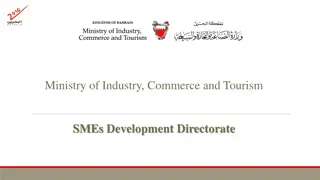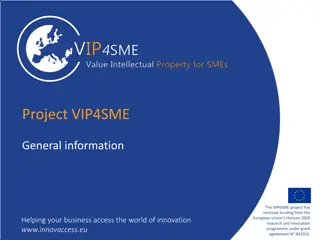IFRS for SMEs FIA Technical Workshop Summary
This presentation provides an overview of the IFRS for SMEs, focusing on key topics such as qualitative characteristics, inventory, PP&E, intangibles, leasing, and related party disclosures. It also covers the background of the standard, benefits for SMEs, and the transition process to full IFRS. Additionally, a video summary by Darrel Scott, an IASB Member, is included to provide further insights. The aim is to facilitate understanding and implementation of the standard among SMEs.
Download Presentation

Please find below an Image/Link to download the presentation.
The content on the website is provided AS IS for your information and personal use only. It may not be sold, licensed, or shared on other websites without obtaining consent from the author. Download presentation by click this link. If you encounter any issues during the download, it is possible that the publisher has removed the file from their server.
E N D
Presentation Transcript
IFRS for SMEs FIA Technical Workshop Saturday 17th March 2018 Korolevu, FIJI 1
Acknowledgements This presentation is based on various documents including IFRS for SMEs, published by IASB 2015 Amendments to the IFRS for SMEs published by IASB For further information and queries, please contact nacanieli.rika@usp.ac.fj 2
Presentation Summary Part 1 2 3 4 Topic Introduction Overview of the Standard Qualitative Characteristics Focus on Selected Sections of the Standard Inventory PP&E, Intangibles, Impairment Leasing Related Party Disclosures Transition to IFRS for SMEs 3
Part 1 INTRODUCTION 4
Background This standard was first issued in 2009 Expect amendments not more frequently than 3 years (changes will follow/lag full IFRS) Changes will be initiated through Exposure Drafts Based on full IFRS, with modifications to reflect 1. needs of users of SMEs financial statements; and 2. Cost-benefit considerations Organised by topic Notably no guidance on segmented reporting 5
Video Summary Debrief on IFRS for SMEs by Darrel Scott, IASB Member https://www.bing.com/videos/search?q=ifrs+for+smes +video&&view=detail&mid=8A5A126C3D3432CDA3FB8 A5A126C3D3432CDA3FB&&FORM=VRDGAR 6
Benefits of IFRS for SMEs Benefits Facilitates transition to full IFRS Provides consistency with full IFRS (for users who also deal with larger entities) Inspires confidence among financiers Reduces costs and effort for domestic standard setters Issues How many SMEs intend to transition? SMEs that are 100% family owned may not seek external finance and not compare themselves with other entities Can SMEs absorb costs of transition and (complex) reporting? 7
Part 2 OVERVIEW OF THE STANDARD 8
Description of SMEs SMEs are entities which: a) do not have public accountability; and b) publish general purpose financial statements for external users. Examples of external users include owners who are not involved in managing. [Paragraph 1.2] 9
Objective of Financial Statements 1. The objective of an SMEs financial statements is to: provide information about the financial position, performance and cash flows of the entity that is useful for economic decision-making by a broad range of users who are not in a position to demand reports tailored to meet their particular needs. 2. Financial statements also show the results of the stewardship of management accountability for the resources entrusted to it. [Paragraphs 2.2 & 2.3] 10
Public Accountability An entity has public accountability if: a) its debt or equity instruments are traded in a public market, or it is in the process of issuing such instruments for trading in a public market e.g. stock exchange or an over-the-counter market; or b) it holds assets in a fiduciary capacity for a broad group of outsiders as one of its primary businesses most banks, credit unions, insurance companies, securities brokers/dealers, mutual funds and investment banks would meet this criterion. [Paragraph 1.3] 11
Clarification on Public Accountability An entity is not publicly accountable if it holds assets in a fiduciary capacity for reasons incidental to a primary business Some entities hold and manage financial resources entrusted to them by clients, customers or members not involved in management of the entity. e.g. travel or real estate agents, schools, charitable organisations, and sellers that receive payment in advance of delivery of the goods or services such as utility companies. Schools generate operating income from education, not interest or dividends [Paragraph 1.4] 12
Separate Statements of Subsidiaries A subsidiary whose parent uses full IFRS, or that is part of a consolidated group that uses full IFRS is not prohibited from using this Standard in its own financial statements provided it does not have public accountability itself. If the subsidiary s financial statements are described as conforming to the IFRS for SMEs, it must comply with all of the provisions of this Standard. [Paragraph 1.6] 13
Separate Statements of Parents A parent entity assesses its eligibility to use this Standard in its separate financial statements on the basis of its own status without considering whether other group entities have, or the group as a whole has, public accountability. If a parent entity by itself does not have public accountability, it may present its separate financial statements in accordance with this Standard even if it presents its consolidated financial statements in accordance with full IFRS or another set of GAAP. [Paragraph 1.7] 14
Undue Cost or Effort An undue cost or effort exemption is specified for some requirements in this Standard. Assessment of undue cost or effort depends on a) the entity s specific circumstances ;and b) management s judgement of the costs and benefits from applying that requirement. Consider how the economic decisions of expected users could be affected by not having that information. Whenever an entity uses this exemption, it must disclose that fact and the reasons why applying the requirement would involve undue cost or effort. 15
Clarification of Undue Cost or Effort Applying a requirement would involve undue cost or effort by an SME if the incremental cost (e.g. valuers fees) or additional effort (e.g. endeavours by employees) substantially exceed the benefits that users are expected to receive from having the information. This assessment would usually apply a lower hurdle than such an assessment for a publicly accountable entity because SMEs are not accountable to public stakeholders. 16
Part 3 QUALITATIVE CHARACTERISTICS 17
Overarching Principles The standard doesn t have a conceptual framework. However it identifies the following characteristics of useful information a) Understandability b) Relevance, Materiality & Timeliness c) Reliability, Substance over Form, Prudence & Completeness d) Comparability e) Balance between Benefit and Cost; and Undue Effort 18
Understandability Information provided in financial statements should be presented in a way that makes it comprehensible by users who have a) a reasonable knowledge of business and economic activities and accounting ;and b) a willingness to study the information with reasonable diligence. The need for understandability does not allow relevant information to be omitted on the grounds that it may be too difficult for some users to understand. 19
Relevance Information provided in financial statements must be relevant to the decision-making needs of users. Information is relevant when it is capable of influencing the economic decisions of users by helping them a) evaluate past, present or future events or b) confirm or correct their past evaluations. 20
Materiality Information is material (and therefore has relevance) if its omission or misstatement could influence the economic decisions of users made on the basis of the financial statements. Materiality depends on the size and nature of the omission or misstatement judged in the surrounding circumstances. It s inappropriate to make, or leave uncorrected, immaterial departures from the standardto achieve a particular presentation of an entity s financial position, financial performance or cash flows. 21
Timeliness Timeliness involves providing information within the decision time frame. Information may lose its relevance if there is undue delay in reporting Management may need to balance the relative merits of timely reporting and the provision of reliable information. In achieving balance between relevance and reliability, the overriding consideration is how best to satisfy the needs of users in making economic decisions. 22
Reliability Information is reliable when it a) is free from material error and bias and b) Faithfully represents that which it either purports to represent or could reasonably be expected to represent. Financial statements are not free from bias (i.e. not neutral) if by the selection or presentation of information they are intended to influence decision-making or judgement in order to achieve a predetermined result or outcome. 23
Substance over Form Enhances the reliability of financial statements. Transactions and other events and conditions should be accounted for and presented in accordance with their substance and not merely their legal form. 24
Prudence Many events and circumstances (especially estimates) involve uncertainties. These are acknowledged by a) Disclosing their nature and extent and b) Exercising prudence when preparing of financial statements. i.e. including a degree of caution when exercising judgements such that assets or income are not overstated and liabilities or expenses are not understated. Prudence does not permit bias. i.e. deliberate understatement or overstatement. 25
Completeness To be reliable, information in financial statements must be complete within the bounds of materiality and cost. An omission can cause information to be false or misleading and thus unreliable and deficient in terms of its relevance. 26
Comparability Users must be able to compare the financial statements of an entity through time; and of different entities Hence, measurement and display of the financial effects of like transactions, events and conditions must be carried out in a consistent way throughout an entity, over time across entities. Also, users must be informed of a) the accounting policies employed in preparing financial statements b) any changes in those policies and their effects 27
Balance between Benefit and Cost Benefits derived from information should exceed the cost of providing it. a) Costs and benefits are not necessarily borne by the same parties b) Benefits often enjoyed by a broad range of external users (public interest and externalities) e.g. Financial information helps capital providers make better decisions, increasing the efficiency of capital markets and reducing the cost of capital for the economy as a whole. Individual entities also enjoy benefits e.g. improved access to capital markets,and lower costs of capital. 28
Part 4 FOCUS ON SELECTED SECTIONS 29
Section 13 Inventory Use the same measurement method for inventory items that are similar in nature a) FIFO b) Weighted Average LIFO is not permitted 30
Section 17 PP&E Under the 2017 amendments, SMEs can now measure PP&E (after initial recognition) using either a) Cost model (borrowing costs are not capitalised) b) Revaluation model Applied to the entire class of PP&E Made with sufficient regularity Previously SMEs could only use the cost model Inconsistent with full IFRS Consider why SMEs might want this flexibility Presumably they would only choose to incur the costs of revaluation if they stand to benefit. 31
Section 17 PP&E For large/complex assets, components must be depreciated separately If their economic benefits are consumed according to significantly different patterns Depreciation methods should reflect expected consumption of economic benefits a) Straight line b) Diminishing balance c) Units of use 32
Section 27 Impairment of Assets At each reporting date, assess indications that an asset may be impaired. a) If any such indication exists, estimate the recoverable amount of the asset. Otherwise, it s not necessary to estimate the recoverable amount. b) If it s impossible to estimate the recoverable amount of an individual asset, estimate the recoverable amount of the cash-generating unit to which it belongs. smallest identifiable group of assets that includes the asset and generates cash inflows that are largely independent from other assets or groups of assets. 33
Section 27 Impairment of Assets External sources of information a) during the period, an asset s market value has declined significantly more than would be expected as a result of the passage of time or normal use. b) significant changes with an adverse effect on the entity have taken place during the period (or will take place in the near future) in the technological, market, economic or legal environment in which the entity operates or in the market to which an asset is dedicated. 34
Section 27 Impairment of Assets External sources of information about Impairment c) market interest rates or other market rates of return on investments have increased during the period, and those increases are likely to affect materially the discount rate used in calculating an asset s value in use and decrease the asset s fair value less costs to sell. d) the carrying amount of the net assets of the entity is more than the estimated fair value of the entity as a whole. 35
Section 27 Impairment of Assets Internal sources of information about Impairment a) evidence is available of obsolescence or physical damage of an asset. b) significant changes with an adverse effect on the entity have taken place during the period (or are expected to take place in the near future), in the extent to which, or manner in which, an asset is used e.g. the asset becoming idle, plans to discontinue or restructure the operation to which an asset belongs and plans to dispose of an asset before the previously expected date. 36
Section 27 Impairment of Assets Internal sources of information about Impairment c) evidence is available from internal reporting that indicates that the economic performance of an asset is, or will be, worse than expected. In this context economic performance includes operating results and cash flows. 37
Section 18 Intangible Assets other than Goodwill Only recognise an intangible asset if the following conditions are met: a) Probable that expected future benefits attributable to the asset will flow to the entity b) Cost of value of the asset can be measured reliably c) Asset does not result from expenditure incurred internally on an intangible item Only measured at cost i.e. no option to revalue these assets. 38
Section 18 Intangible Assets other than Goodwill All intangible assets are considered to have a finite useful life Under the 2017 amendments, if the useful life cannot be established reliably, It shall be determined based on management s best estimate but shall not exceed 10 years. This also applies to goodwill. Previously SMEs were required to amortise such items over 10 years 39
Section 19 Business Combinations & Goodwill Under 2017 amendments, the acquirer is exempted from recognising acquiree s assets and liabilities if the fair value of a) an intangible asset can t be measured reliability without undue cost or effort b) a contingent liability can t be measured reliably The acquirer must provide a qualittative description of the factors that make up any goodwill recognised e.g. expected synergies from combining operations of the acquirer and acquiree or intangible assets not recognised for reasons above 40
Section 20 Leases SMEs are still required to apply differential treatment for finance and operating leases Based on transfer of risks and rewards incidental to ownership Depends on substance of the transaction rather than form of the contract e.g. Ownership transferred by the end of the lease term Lease term covers majority of economic life PV of MLP substantially equals fair value May apply to some outsourcing arrangements 41
Section 33 Related Party Disclosures A related party is a person or entity that is related to the reporting entity: a) a person or a close member of that person s family is related to a reporting entity if that person: i. is a member of the key management personnel of the reporting entity or of a parent of the reporting entity; ii. has control or joint control over the reporting entity; or iii. has significant influence over the reporting entity. 42
Close family member Those family members who may be expected to influence, or be influenced by, that person in their dealings with the entity ,including: a) that person s children and spouse or domestic partner; b) children of that person s spouse or domestic partner; and c) dependentsof that person or that person s spouse or domestic partner. 43
Section 33 Related Party Disclosures b) an entity is related to a reporting entity if any of the following conditions applies i. the entity is controlled or jointly controlled by a person identified in (a). ii. the entity, or any member of a group of which it is a part, provides KMP services to the reporting entity or to the parent of the reporting entity. iii. a person identified in (a)(ii) has significant influence over the entity or is a member of the KMP of the entity (or of a parent of the entity). 44
Section 33 Related Party Disclosures The following are not necessarily related parties: a) two entities simply because they have a director or other member of KMP in common; b) two venturers simply because they share joint control over a joint venture; 45
Section 33 Related Party Disclosures c) any of the following simply by virtue of their normal dealings with an entity: i. providers of finance; ii. trade unions; iii. public utilities; or iv. government departments and agencies. d) a customer, supplier, franchisor, distributor or general agent with whom an entity transacts a significant volume of business, merely by virtue of the resulting economic dependence. 46
Section 35 Transition An entity s first financial statements that conform to this Standard are the first annual financial statements in which the entity makes an explicit and unreserved statement in those financial statements of compliance with the IFRS for SMEs. 47
Section 35 Transition Financial statements prepared in accordance with this Standard are an entity s first such financial statements if the entity: a) did not present financial statements for previous periods; b) presented its most recent previous financial statements under national requirements that are not consistent with this Standard in all respects; or c) presented its most recent previous financial statements in conformity with full IFRS. 48
Section 35 Transition Use of deemed cost c) fair value as deemed cost. A first-time adopter may elect to measure an item of PP&E, an investment property or an intangible asset on the date of transition to this Standard at its fair value and use that fair value as its deemed cost at that date. d) revaluation as deemed cost. A first-time adopter may elect to use a previous GAAP revaluation of an item of PP&E, an investment property or an intangible asset at, or before, the date of transition to this Standard as its deemed cost at the revaluation date. 49
Section 35 Transition Use of deemed cost da) event-driven fair value measurement as deemed cost. A first-time adopter may have established a deemed cost in accordance with its previous GAAP for some or all of its assets and liabilities by measuring them at their fair value at one particular date because of an event e.g. a valuation of the business, or parts of the business, for the purposes of a planned sale. 50




